Colder temperatures can signal the beginning of a sleepy time of year in the garden, as many plants are preparing themselves for several months of dormancy. These 10 cold-hardy succulents can handle low temperatures, many of them down to 0 and even minus 20 degrees Fahrenheit, meaning you don’t have to settle for a bare winter garden. All of them look great year-round, but they especially shine in the cool season, adding texture and color to the typical evergreen landscape.
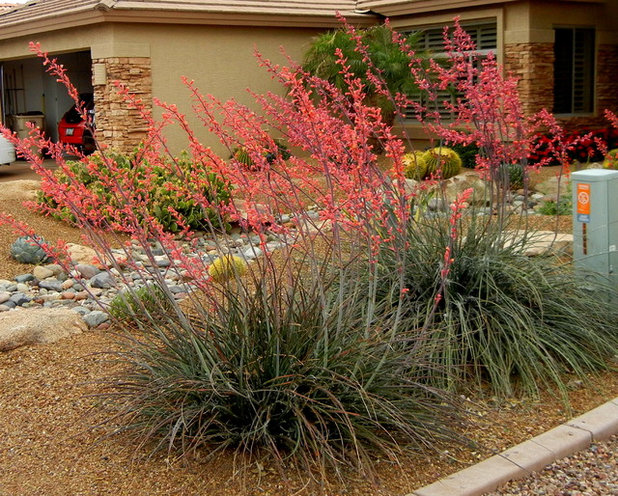
Noelle Johnson Landscape Consulting
Red Yucca(
Hesperaloe parviflora)
Native to Texas and northern Mexico
Red yucca’s succulent leaves mimic an ornamental grass by creating graceful mounds of evergreen foliage.
Flowering occurs primarily throughout the spring and summer months. Five-foot-tall stalks with coral-colored flowers, attractive to hummingbirds, herald the arrival of warm weather. In addition to the more common coral color, there are varieties that produce creamy yellow and dark red flowers.
Red yucca’s ability to thrive in full sun, whether planted in the ground or in containers, makes it a valuable addition to the landscape.
Where it will grow: Hardy to minus 20 degrees Fahrenheit, or minus 29 degrees Celsius (USDA Zone 5; find your zone), depending on the species.
Water requirement: Drought-tolerant once established; water deeply every three weeks in summer, monthly in spring and fall, and rely on natural rainfall in winter; in low-desert gardens, water twice a month spring through fall.
Light requirement: Full sun is best but will grow in light shade.
Mature size: 3 to 4 feet wide and 3 feet tall (5 feet tall when in flower).
Planting notes: Plant in well-drained soil in full sun or filtered shade.
Learn more about growing red yucca

PixelFänger
Hens and Chicks(
Sempervivum spp.)
Native to the mountains of Central and Southern Europe and the islands of the Mediterranean
Hens and chicks, also known as houseleek, has legions of fans who love to watch the mother plant, or the “hen,” produce small baby plants, or “chicks.” There are as many as 50 species of
Sempervivum and even more hybrids and cultivars, resulting in countless variations in color, shape and size.
Typically used as a ground cover in rock gardens or tucked into the side of a stone wall,
Sempervivum will grow with little attention. It’s also a popular container plant and can be brought indoors in areas that experience rainy winters, to protect it from getting too wet.
As with most succulents, it should be grown in well-drained soil and watered only when the soil is completely dry. Remember that you’re more likely to kill a succulent by giving it too much water rather than too little.
Where it will grow: Hardy to minus 30 degrees Fahrenheit, or minus 34 degrees Celsius (zones 4 to 9).
Water requirement: Once established, water infrequently, allowing the soil to dry out before watering again.
Light requirement: Full sun to filtered shade.
Mature size: Rosettes are ½ to 6 inches wide, depending on the species.
Planting notes: Plant in well-drained soil in full sun or filtered shade.
Learn more about growing hens and chicks
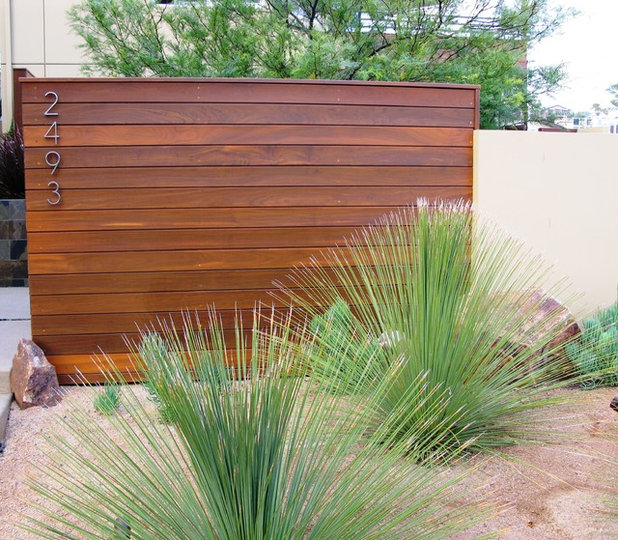
debora carl landscape design
Texas Sotol(
Dasylirion texanum)
Native to Texas and the Chihuahua region of Mexico
The deep green leaves and spiky texture of Texas sotol, also called green desert spoon, add color to the often dormant and colorless winter landscape. Its growth habit causes the leaves to fan out, creating a semi-spherical fan shape that brings interest to the drought-tolerant landscape throughout the year. A single flowering spike 10 to 15 feet tall may sometimes appear in summer on mature specimens; white flowers attractive to hummingbirds cover the spike.
This Texas native isn’t fussy and is happy growing in a spot with well-drained soil that receives full sun. Plant in groups for a striking landscape statement. Common sotol (
Dasylirion wheeleri), a gray-blue relative native to Texas, Arizona, New Mexico and northern Mexico, is also a great cold-hardy choice.
Where it will grow: Hardy to minus 20 degrees Fahrenheit, or minus 29 degrees Celsius (Zone 5).
Water requirement: Drought-tolerant; water monthly spring through fall; in low-desert gardens, water twice a month spring through fall and monthly in winter.
Light requirement: Full sun.
Mature size: 5 feet tall and wide.
Planting notes: Plant in well-drained soil in full sun.
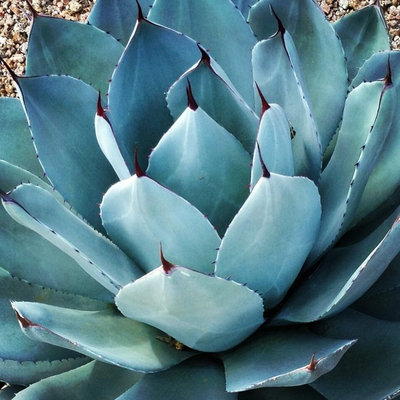
Noelle Johnson Landscape Consulting
Parry’s Agave(
Agave parryi)
Native to Arizona, New Mexico, Texas and northern Mexico
Parry’s agave comprises several varieties highly prized for their ornamental rosette pattern, which resembles an artichoke. Artichoke agave
(Agave parryi var.
truncata) is the most notable variety and is hardy to 10 degrees Fahrenheit, or minus 12 degrees Celsius; it has gray-blue leaves with contrasting maroon teeth. Other varieties of this small- to medium-sized agave include
A. parryi var.
couesii, which is hardy to 0 degrees Fahrenheit, or minus 18 degrees Celsius.
A. parryi ssp.
neomexicana is the most cold-hardy variety and can survive temperatures as low as minus 20 degrees Fahrenheit, or minus 29 degrees Celsius.
These look great planted in groups of three and intermixed with smaller ornamental grasses such as blue grama (
Bouteloua gracilis). Parry’s agave can also make a statement on its own when planted next to a boulder. This agave makes a great container plant and can be brought indoors in areas that experience winter temperatures colder than the tolerances stated below.
Where it will grow: Hardy from 10 degrees Fahrenheit, or minus 12 degrees Celsius, to minus 20 degrees Fahrenheit, or minus 29 degrees Celsius (zones 5 to 9), depending on the variety.
Water requirement: Low; water monthly in summer; in low-desert regions, water twice a month in summer.
Light requirement: Full sun to filtered shade.
Mature size: 1½ to 3 feet tall and wide.
Planting notes: Plant in well-drained soil in full sun or filtered shade.
Learn more about growing Parry’s agave
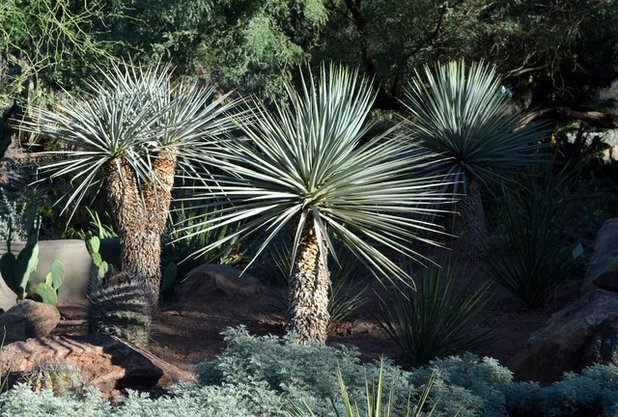
Noelle Johnson Landscape Consulting
Thompson’s Yucca(
Yucca thompsoniana, formerly
Y. rostrata)
Native to western Texas and the Chihuahua and Coahuila regions of Mexico
Thompson’s yucca, also called beaked yucca and Big Bend yucca, is an iconic, tree-like plant that stands sentinel throughout many natural areas of the Southwest and is equally at home in residential landscapes.
Younger yucca plants grow as a single stem, while the older ones can branch at the top. The blue-gray leaves are arranged in a rosette pattern and occur on the top portion of the stem. As the 2-foot-long leaves age, they turn light tan and cover the stem, which can be left alone or pruned close for a decorative look. Clusters of white flowers appear in late spring.
Where it will grow: Hardy to minus 20 degrees Fahrenheit, or minus 29 degrees Celsius (zones 5 to 9).
Water requirement: Low.
Light requirement: Full sun.
Mature size: 10 feet tall and 3 feet wide.
Planting notes: Plant in well-drained soil in full sun.

Noelle Johnson Landscape Consulting
Upright Myrtle Spurge(
Euphorbia rigida)
Native to the Mediterranean
The blue-gray color of upright myrtle spurge, also called silver spurge, provides lovely color contrast when planted alongside plants with darker foliage. The unique spiky texture of the leaves also adds a decorative element to the landscape. Chartreuse flowers appear in late winter and spring, adding a welcome splash of color.
Where it will grow: Hardy to 0 degrees Fahrenheit, or minus 18 degrees Celsius (zones 7 to 9).
Water requirement: Low; water every two to three weeks in summer and monthly in winter in the absence of rain.
Light requirement: Full sun to filtered shade.
Mature size: 2 feet tall and 3 feet wide.
Planting notes: Plant in well-drained soil in full sun or filtered shade; prune back flowering stems in late spring.
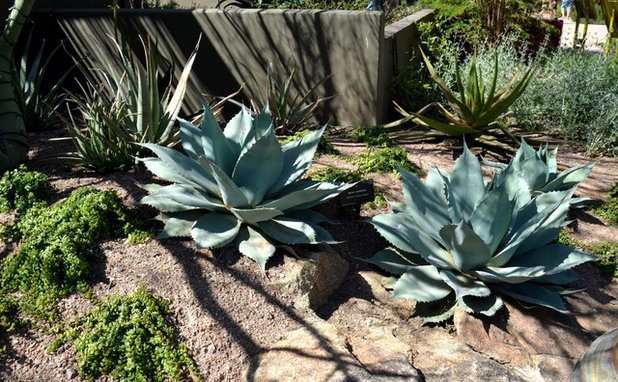
Noelle Johnson Landscape Consulting
Whale’s Tongue Agave(
Agave ovatifolia)
Native to northeastern Mexico
With its wide, curved leaves, it’s easy to see where whale’s tongue agave gets its common name. This blue-gray, medium-sized agave serves as an attractive accent plant throughout the year. Whether planted next to large boulders or used in containers, it provides welcome interest when other plants go dormant in winter.
The sharp terminal spines can be clipped off to avoid being inadvertently pricked. Like all agave, this Mexican native will flower just before it dies.
Where it will grow: Hardy to 0 degrees Fahrenheit, or minus 18 degrees Celsius (zones 7 to 9).
Water requirement: Low to moderate; water monthly spring through fall and in winter in the absence of rainfall; in low-desert gardens, water every two weeks spring through fall.
Light requirement: Full sun to light shade; provide light shade in low-desert landscapes.
Mature size: 3 to 4 feet tall and wide.
Planting notes: Plant in well-drained soil in full sun or filtered shade.
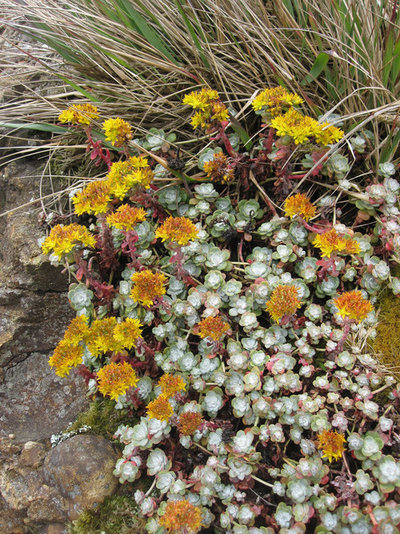 Broadleaf Stonecrop
Broadleaf Stonecrop(
Sedum spathulifolium)
Native to the western regions of British Columbia, Washington, Oregon and California; often seen growing on rocky hillsides
Broadleaf stonecrop’s small gray-blue leaves arranged in rosette shapes create a pleasing succulent ground cover. In winter, the outer leaves turn an attractive burgundy color in response to the cooler temperatures. Yellow flowers transform this cold-hardy succulent in summer.
This Northwestern native, also called Pacific stonecrop, grows best in conditions similar to its native habitat, with rocky, well-drained soil, so avoid planting in areas where water will pool. Because of its rather small size, broadleaf stonecrop looks great tucked in the nooks and crannies of a rock garden, grown in containers where it can trail over the edge, or even in a fairy garden.
Where it will grow: Hardy to minus 5 degrees Fahrenheit, or minus 21 degrees Celsius (Zone 6).
Water requirement: Once established, water infrequently in the absence of rainfall, allowing the soil to dry out before watering again.
Light requirement: Full sun to filtered shade.
Mature size: 2 inches tall spreading to 24 inches wide.
Planting notes: Plant in well-drained soil in full sun or filtered shade.
Learn more about growing broadleaf stonecrop
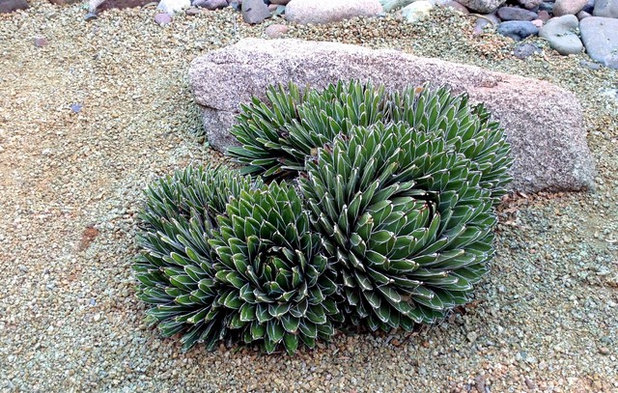
Noelle Johnson Landscape Consulting
Queen Victoria Agave (
Agave victoriae-reginae)
Native to the Chihuahuan Desert region of Mexico
Many describe Queen Victoria agave as the most decorative agave species. Despite being less than 2 feet tall and wide, it makes quite an impression with its dark green leaves arranged in a tight rosette pattern and the stark contrast of its white leaf margins. The leaves curve inward and have smooth edges that end in a spine at the tip of each leaf.
Plant next to boulders for a natural look or in rows for a contemporary design. This small agave also makes a great container plant and can be brought indoors during the winter in Zone 6 and below.
Where it will grow: Hardy to 10 degrees Fahrenheit, or minus 12 degrees Celsius (zones 7 to 9).
Water requirement: Drought-tolerant once established; water deeply once a month spring through fall and in winter in the absence of rainfall; in low-desert landscapes, water every two weeks in summer.
Light requirement: Full sun is required for maintaining a tight rosette shape.
Mature size: Up to 18 inches tall and wide.
Planting notes: Plant in well-drained soil in full sun.
Learn more about growing Queen Victoria agave
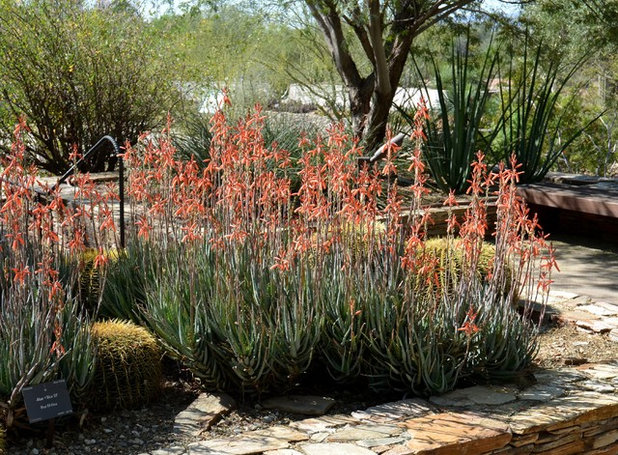
Noelle Johnson Landscape Consulting
‘Blue Elf’ Aloe(
Aloe ‘Blue Elf’)
Aloes are native to South Africa, but parentage of this hybrid is unknown
While most aloe species need relief from the hot afternoon sun, ‘Blue Elf’ aloe thrives in full sun, including areas that receive hot, reflected sun. Combine its sun and heat tolerance with the beautiful orange flowers that appear in late winter into spring and it’s easy to see why ‘Blue Elf’ aloe is rapidly becoming a favorite in drought-tolerant gardens.
The cold tolerance of this aloe is better than other aloe species, increasing the areas where it can be grown outdoors all year long. Plant in groups of three to five in raised beds or along pathways for greatest effect. ‘Blue Elf’ aloe also makes an attractive low-maintenance container plant that can be brought inside for winter in Zone 7 and below.
Where it will grow: Hardy to 15 degrees Fahrenheit, or minus 9 degrees Celsius (Zone 8).
Water requirement: Drought-tolerant once established but does best when watered deeply twice a month in the summer and once every three weeks in spring and fall; in low-desert gardens, water twice a month spring through fall.
Light requirement: Full sun is best, but will grow in light shade; tolerates reflected sun.
Mature size: Up to 18 inches tall and 2 feet wide.
Planting notes: Plant in well-drained soil in full sun or filtered shade.
Learn more about growing ‘Blue Elf’ aloe





